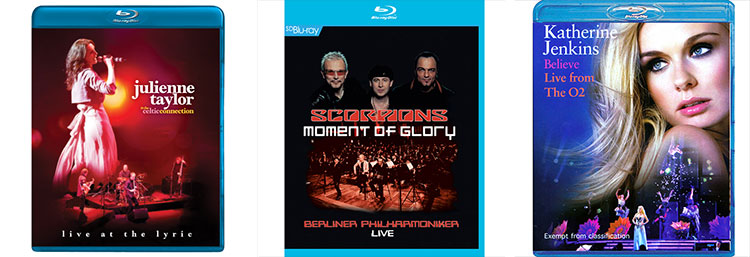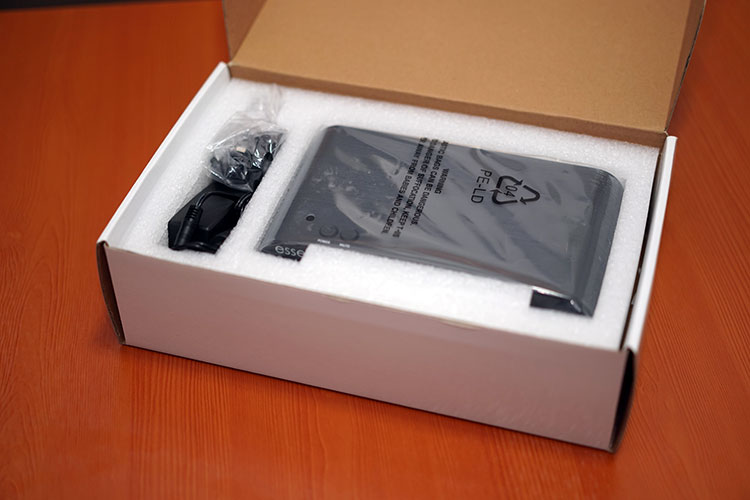Blu-Ray Music
Labels
I am a bit of a newcomer to Blu-ray audio disks but the market now has quite a wide range of options out there for the hardcore audiophile.
For instance, Universal has launched their High Fidelity Pure Audio or HFPA standard in 2013 which touts higher quality or at least SCAD level or higher on Blu-ray.
Other labels such as Evosound have their HD range of Blu-ray concerts and they pretty much dominate our local stores so most of what was used in this review were pulled from that label.
Bit Rates
One thing to note if you are shopping just because it’s Blu-ray does not automatically mean the audio track is going to be higher quality than the CD version, it all depends on the bit depth and sample rate the whole thing is produced in and laid down on the disk. Not all will be 24/96. You can find more information on the sample rate and bit depth on the back of the Blu-ray case.
We decided on 3 samples, one of which, Julienne Taylor – Live at the Lyric was a full 24BIt 29kHz experience and the other 2, not accounting for taste, were 48k each with the Scorpions having the higher 24BIT depth. Those two were Katherine Jenkins – Believe Live from the O2 and Scorpions – Moment of Glory Live from Berlin. We also grabbed 3 digital copies of the same disks with 48k audio mixes for comparison purposes.
Sound Impressions
The setup used includes the headphone amp output of the HDACC itself and the transparent but very powerful balanced output (7W) of the Cayin iHA-6 headphone amp via the HDACC dual RCA analog output.
Julienne Taylor – Live at the Lyric
Ambiance
Live at the Lyric provides the best audio experience out of the three chosen using the HDACC. It is not just the flawless 24/96 recording but the Lyric acoustics itself. This is not the biggest arena, certainly a lot smaller than the 02 and the Hannover EXPO but it is much more suitable for the scaled down ensemble of Julienne’s band which consists of just 4 people.
It’s less grandiose and more intimate and rightly so given its really Julienne’s breathy vocal performance that is the star of the show. Combined with the Lyric theater ambiance you can hear a pin drop which is probably the stiffest test of the HDMI performance on the HDACC.
Black Background
If there is noise you will hear it, if there is sibilance it will ring loud and true. None of that was present using the HDMI link up. The HDACC rendered a perfectly black background with its own headphone output using medium efficiency headphones. Connected to the Cayin iHA-6 headphone amp, harder to drive planar headphones such as the Susvara produced stunning results with a very life-like presentation and impressive levels of detail.
Timbre
Instrumental timbre and imaging need to be accurate also. It may not be the most stretched out band or the most dynamic of visual treats so the ear is going to pick up on any inaccuracies pretty quickly. What I picked up on immediately with the HDMI performance was the level of control with instruments and vocals. There was just enough decay for flute performances to sound full and engaging and just enough smoothness for breathy vocals without loss of details.
Dynamics
Now it may have well been partly due to the recording and perhaps partly due to the combination of 7W headphone amp and the pretty awesome Susvara but I honestly found the entire performance to be faultless from start to finish for accurate timbre and fantastic dynamics. The interlude before each track, that moment before the performance starts and the crowd hushes was incredibly black, life like in its absence of noise, and fantastic for dynamics when the first note hits.
Katherine Jenkins – Believe Live from the O2
Believe Live from the O2 was recorded in 16BIT 48k (6 channel) so right away there will be some quantitative difference in the reproduction compared to the Julienne Taylor superior 24/96 recording. However, the more immediate difference is the recorded ambiance of the concert which is totally different to the Live at the Lyric experience.
Ambiance
With the Taylor recordings, it’s all about minute detail, vocals and achieving the best possible black background which the HDACC does very well, especially as a DAC to a high-end amp. With the Jenkins recording its all about scale and staging in the opposite direction yet still with Jenkins cross over Mezzo soprano vocals front and center.
A good DAC and amp combo needs to capture the sheer size of the production and imaging as well as the accuracy of a large orchestral component to the performance without losing Jenkins vocals in the mix.
Staging and layering
No question the HDMI version had superior depth and imaging with a far more holographic staging quality when compared with the flatter vaguer 48k stereo FLAC stream via USB. Even with more timid imaging cans like the Edition X V2, there was a clear difference between the compressed feel of the 48k 16BIT FLAC stream and the uncompressed PCM stereo stream from the disk using HDMI. Dynamics also was marginally superior via the HDMI connection using the HDACC amp output with nuanced detail just that bit more noticeable.
Vocals
Using the HD800 from the HDACC with ohm setting to 300-ohms the difference was palatable also. With the Flac recording via USB Katherine’s vocals fell back a bit into the orchestra and lost a little in body. Switching back to the disk via HDMI immediately the vocals sounded more accurate and life like. Instrumental positioning was not as flat allowing for better spacing and generally an airier feel to the recording.
Balanced
The biggest jump was moving to an external amp, the iHA-6 from the HDACC’s own amp. The studied difference between the FLAC and HDMI recordings became a ridiculous gap using the balanced output of the IHA-6. We are talking better levels of gain, dynamics, and a fuller richer sound. You can argue the balanced output will do that but we are talking difference between balanced output using the FLAC and balanced output using the disk. A very clear demonstration of the rich potential with a good amp.
Scorpions – Moment of Glory Live from Berlin
Again, this is a 48k mastered recording but unlike the Believe master, this is a 24BIT recording as opposed to 16BIT. Embedded also are two separate audio streams, 2 channel and 6 channel so you should be able to pick out the stereo stream from the disk options without any compression.
Ambiance
Much like the Jenkins recording the Moment of Glory production is huge with the Berlin Philharmonic orchestra in tow, however, there is less of a focus on the vocal performance of Klaus Meine, good as it is, and more of a wider presentation to incorporate the interaction between the band and the orchestra on some well-known hits.
If you have experienced the sheer power and scale of S&M from Metallica then you know just how musically powerful these type of scores can be. A good DAC and Amp combo not only needs to scale the performance well but it needs to sound powerful, musical and retain a high level of clarity to squeeze in all those instruments without sounding like a compressed mess.
Dynamics
Using the HD800 and again I got the exact same experience I had with the Katherine Jenkins Believe test disk. The FLAC stereo stream using the USB DAC output and balanced to the iHA-6 sounded limp, compressed and lacking in pop, the dynamics simply didn’t stand up to the test. Neither the guitar work nor Klaus’s vocals had any power sounding rather compressed. I also had a slight reduction in gain so volume had to go up a touch also.
With the Blu-ray DTS-HD stream or even the PCM stereo stream with the exact same setup just switching to the HDMI output, the dynamic range jump was huge, the clarity and detail went up a notch also. The staging was far deeper and wider. I cannot imagine anyone would be happy with the USB FLAC version and an HD800 after using the HDMI output.
Matching
The HDACC’s own amp output is pretty good, the ES9012 DAC has a fairly natural sounding tone with a good eye for detail so if you are working with dynamic headphones you will get good resolution and a smooth performance.
Power
The iHA-6 amp combo works better using the balanced output of the HDACC DAC. This is an ideal pairing for higher powered planars or highly efficient IEMs and earphones as well as taking noise suppression that bit further. IEM’s are the major weakness of the HDACC so for a recording like this I would recommend less efficient headphones to get it as quiet as possible.
With the IHA-6 amp, you get a big lift in dynamics over the HDACC amp output as well as a tighter low end and better resolution. Of course, you can run IEMs with a lower noise floor using the HDACC pre-amping capabilities.
Our Verdict
You can probably tell how pleased I am with the HDMI/Blu-ray performance over the standard FLAC version of the same disk. It is a clear win for the Essence HDACC and doubly so if used as a balanced DAC to proper dedicated headphone amp such as the Cayin iHA-6. The difference in quality was so easy to pick out it hardly felt fair.
But this begs the question – why isn’t everyone using an Essence HDACC at some point in their system? Much of the answer I suspect is beyond Essence’s control. Physical media is a shrinking platform though people like me still much prefer them. Streaming content is grabbing a lot of the market share. Physical media that is thriving, such as vinyl, is largely irrelevant. Its crossover appeal is undeniable to home entertainment users who may lack a top-notch receiver but at $499 good receivers are within grasp (not great ones).
As a headphone user, I do recommend using the HDACC as a DAC more as a standalone unit. Decent as the amp maybe, the DAC combined with the HDMI capability is where this unit truly shines. I scored the system as a regular DAC/Amp with 8.0 last year, but as a tool to unlock audio via HDMI, it warrants a higher score.
Given the age of the system, I sort of hope we see a revised chip-set and amp stage in the not too distant future. One that does not require a high-end amp to maximize planar or HD800 performance. It is fine if such a revision comes at a higher price, given the market conditions right now $499 for the current version is a bloody steal already.
Technical Specifications
| Fs = 44.1 to 96 kHz, 20 to 20 kHz BW, 1 kHz test tone, 0 dBFS = +24 dBu (unless noted): | |
| SNR – A-Weighted, (0 dBFS = +20 to +29 dBu): | 109 dB |
| SNR – Unweighted, (0 dBFS = +20 to +29 dBu): | 107 dB |
| THD+N, 1 kHz at 0 dBFS: | -85 dB, 0.005095% |
| THD+N, 1 kHz at –1 dBFS: | -87 dB, 0.004849% |
| THD+N, 1 kHz at –3 dBFS: | -89 dB, 0.004521% |
| THD+N, 20 to 20 kHz test tone at –3 dBFS: | -89 dB, 0.004521% |
| Frequency Response at Fs=48 kHz: | ±0.1 dB (20 to 20kHz) |
| ±0.2 dB at 20 Hz | |
| -0.2 dB at 20 kHz | |
| Frequency Response at Fs=96 kHz: | ±0.1 dB (20 to 20kHz) |
| -0.25 dB at 20 Hz | |
| -0.2 dB at 20 kHz | |
| Crosstalk | -113 dB at 20 kHz |
| -118 dB at 1 kHz | |
| -119 dB at 20 Hz | |
| Interchannel Differential Phase (Stereo Pair): | ±0.1 degrees at 1 kHz – any sample rate |
| Interchannel Differential Phase (Between DAC1 Units Fs<110): | ±0.1 degrees at 1 kHz – Fs < 110 kHz |
| Interchannel Differential Phase (Between DAC1 Units Fs>110): | ±0.1 degrees at 1 kHz – Fs > 110 kHz |
| Delay (Digital Input to Analog Output): | 3.909 ms at 44.1 kHz |
| 3.592 ms at 48 kHz | |
| 1.956 ms at 88.2 kHz | |
| 1.798 ms at 96 kHz | |
| 0.980 ms at 176.4 kHz | |
| 0.900 ms at 192 kHz | |
| Mute on Receive Error: | Yes |
| Mute on Lock Error: | Yes |
| Mute on Idle Channel: | No |
Input Ports:
- 1×HDMI,
- 1×USB (Type B),
- 1×Coaxial,
- 1×Optical,
- 1×L/R (Analog Stereo 2RCA),
- 1×3.5mm mini analog L/R Phone Jack (L/R)
Output Ports:
- 1×HDMI,
- 1×Coaxial,
- 1×Optical,
- 1×Line L/R (Analog Stereo 2RCA),
- 1×XLR (Balanced Analog Stereo),
- 1×6.3mm Phone Jack (Headphone)
- Digital Audio I/O Support: LPCM 2CH
- Stereo Audio I/O Level: 2 Vrms ±0.2
- XLR Blanced I/O Level: 4 Vrms ±0.2
- Headphone Impedance: 16 Ω ~ 600 Ω
- ESD Protection Human body model: ±8 kV (air-gap discharge)
- ±6 kV(contact discharge)
Power Supply: 100v-280v rated,5 V/3 A DC (US/EU standards, CE/FCC/UL certified)
Dimensions: 223mm (8.9″)W x 138mm (5.5″)D x 50mm (2″)H
Weight: 680 g, 1.8 lbs
Chassis Material: Aluminum
Power Consumption: 15 W







